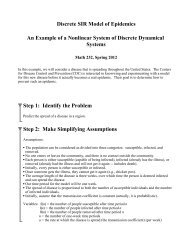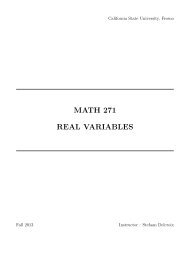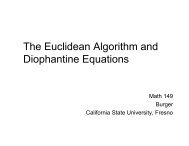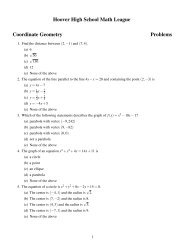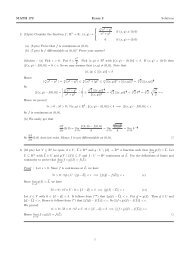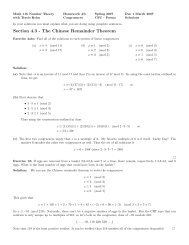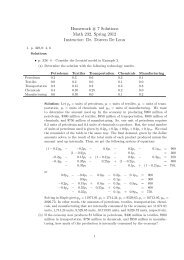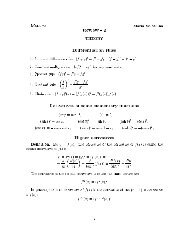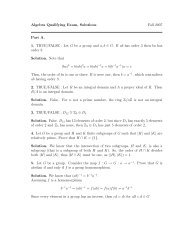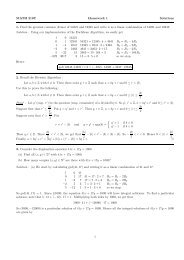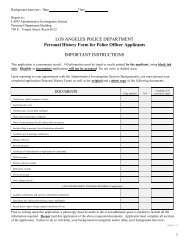MATH 116 Homework 5 Solutions 1. Use successive squaring to ...
MATH 116 Homework 5 Solutions 1. Use successive squaring to ...
MATH 116 Homework 5 Solutions 1. Use successive squaring to ...
- No tags were found...
Create successful ePaper yourself
Turn your PDF publications into a flip-book with our unique Google optimized e-Paper software.
The inverse of 12 modulo 19 is 8 mod 19(b) We start by writing (5693, 1109) as a linear combination of 5693 and1109 :1 0 56930 1 1109 5693 = 1109 · 5 + 148 R 3 = R 1 − 5R 21 −5 148 1109 = 148 · 7 + 73 R 4 = R 2 − 7R 3−7 36 73 148 = 73 · 2 + 2 R 5 = R 3 − 2R 415 −77 2 73 = 2 · 36 + 1 R 6 = R 4 − 36R 5−547 2808 1 2 = 1 · 2 + 0 so we s<strong>to</strong>pHence (−547) · 5693 + 2808 · 1109 = <strong>1.</strong> Modulo 5693, we get that 2808 · 1109 ≡ 1 mod 5693. Hence 2808 is aninverse of 1109 modulo 5693.The inverse of 1109 modulo 5693 is 2808 mod 56934. Solve the following congruence equations :(a) 7x ≡ 2 mod 19(b) 15x ≡ 35 mod 81(c) 20x ≡ 32 mod 92(d) 1109x ≡ 1234 mod 5693Solution : (a) Note that (19, 7) = 1 and 1|2. So the equation 7x ≡ 2 mod 19 will have a unique solution modulo19. First, we find an inverse of 7 modulo 9 by writing (19, 7) as a linear combination of 19 and 7 :1 0 190 1 7 19 = 7 · 3 + (−2) R 3 = R 1 − 3R 2 and change signs−1 3 2 7 = 2 · 3 + 1 R 4 = R 2 − 3R 33 −8 1 2 = 1 · 2 + 0 so we s<strong>to</strong>pHence 3 · 19 + (−8) · 7 = <strong>1.</strong> So (−8) · 7 ≡ 1 mod 19 and −8 is an inverse of 7 modulo 19. Multiplying both sidesof 7x ≡ 2 mod 19 by −8, we get that(−8) · 7x ≡ (−8) · 2 mod 19x ≡ −16 ≡ 3 mod 19x ≡ 3 mod 19(b) Since (15, 81) = 3 but 3 ̸ |35, we know that the equation 15x ≡ 35 mod 81 has no solutions.No solutions(c) Note that (20, 92) = 4 and 4|32. So the equation 20x ≡ 32 mod 92 will have a unique solution modulo 23 orfour solution modulo 92. Dividing both sides of the equation 20x ≡ 32 mod 92 by 4 (make sure <strong>to</strong> adjust themodulus!), we get that925x ≡ 8 mod(4, 92) = 23Now we find an inverse of 5 modulo 23 by writing (23, 5) as a linear combination of 23 and 5 :1 0 230 1 5 23 = 5 · 5 + (−2) R 3 = R 1 − 5R 2 and change signs−1 5 2 5 = 2 · 2 + 1 R 4 = R 2 − 2R 32 −9 1 2 = 1 · 2 + 0 so we s<strong>to</strong>p2
So 2 · 23 + (−9) · 5 = <strong>1.</strong> Hence (−9) · 5 ≡ 1 mod 23 and −9 is an inverse of 5 modulo 23. Multiplying both sidesof 5x ≡ 8 mod 23 by −9, we get that(−9) · 5x ≡ (−9) · 8 mod 23x ≡ −72 ≡ 20 mod 23x ≡ 20 mod 23If we want <strong>to</strong> write down the solutions modulo 92, there will be four solutions. We get that x 0 = 20 is a particularsolution. Hence all solutions are given byx ≡ 20 mod 92 or x ≡ 20+23 ≡ 43 mod 92 or x ≡ 20+2·23 ≡ 66 mod 92 or x ≡ 20+3·23 ≡ 89 mod 92x ≡ 20 mod 92 or x ≡ 43 mod 92 or x ≡ 66 mod 92 or x ≡ 89 mod 92(d) In the previous exercise, we found that 2808 is an inverse of 1109 modulo 5693. Multiplying both sides of1109x ≡ 1234 mod 5693 by 2808, we get that2808 · 1109x ≡ 2808 · 1234 mod 5693x ≡ 2808 · 1234 ≡ 3465072 ≡ 3728 mod 5693x ≡ 3728 mod 56935. Let a, b, c and m be integers with gcd(a, b) = 1 and m > <strong>1.</strong>(a) Let (x 0 , y 0 ) be a particular solution of ax + by = c. Prove that all solutions of ax + by ≡ c mod m aregiven by {x ≡ x0 − bt mod mwhere t ∈ Zy ≡ y 0 + at mod m(b) Deduce that the equation ax + by ≡ c mod m has exactly m incongruent solutions (x, y) modulo m.Proof : (a) First, we show that the given couples are indeed solutions. Let t ∈ Z. Note that ax 0 + by 0 = c.Hencea(x 0 − bt) + b(y 0 + at) = ax 0 − abt + by 0 + bat = ax 0 + by 0 = cSoNext, let (x, y) be a solution ofThen there exists z ∈ Z such tha<strong>to</strong>rWe use the general method <strong>to</strong> solve the equationPut U = aX + bY . Then we have <strong>to</strong> solvea(x 0 − bt) + b(y 0 + at) ≡ cax + by ≡ cmod max + by = c + mzax + by − mz = caX + bY − mZ = c{ U − mZ = caX + bY = Umod m3



